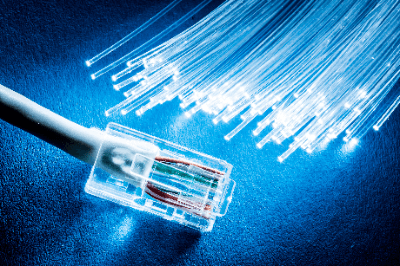What Is a Fiber Optic Cable?

Fiber optic cables are cables used in fiber optic communications that transmit information using optical signals.
Multiple fibers called optical fibers are bundled together and coated. Fiber optic cables are becoming more and more important as the modern internet is shifting from telephone line communications to fiber optic communications.
Optical fiber is a highly transparent fiber made of high-purity glass fiber, which can propagate optical signals over long distances with virtually no attenuation. As a result, high-speed communication over longer distances is possible than over telephone lines.
Uses of Fiber Optic Cables
Major uses of fiber optic cables include various types of measuring instruments, illumination and other lighting, and medical and industrial fiberscopes. Fiber optic cables are used for a variety of applications other than optical lines for the Internet.
Fiberscopes are devices used to observe the inside of devices and human bodies that are difficult to access. Medical endoscopes are also a type of fiberscope, which enables real-time confirmation of affected areas based on optical information propagated through optical fibers.
Principle of Fiber Optic Cables
Fiber optic cables are made up of two types of glass: the core in the center and the cladding around the core. The core is made of glass with a high refractive index and the cladding is made of glass with a slightly lower refractive index. This causes the optical signals in the cable to be totally reflected at the boundary between the core and cladding, allowing optical signals to propagate far without attenuation.
Types of Fiber Optic Cable
Fiber optic cables are classified into two types according to the diameter of the core: single-mode fiber and multimode fiber.
1. Single-Mode Fiber
Single-mode fiber is an optical fiber with a small core diameter (about 10 μm). It transmits only light that is totally reflected at a certain angle. Since the arrival speed of light is constant, large-capacity communications can be carried stably over long distances.
2. Multimode Fiber
An optical fiber with a large core diameter (about 50 μm) that simultaneously transmits multiple beams of light at different angles of total reflection. Since the arrival speed of each light differs, it is not suitable for long distances and is mainly used for short-distance medium- and small-volume communications.
Optical Fiber Cable Connection Methods
There are two main types of optical fiber splicing methods: fusion splicing and connector splicing. Since each method has different characteristics, select the splicing method that best suits the application.
1. Fusion Splicing Method
The tips of optical fibers are heated and melted to bond the tips of two optical fibers. The fusion splicing method requires less space for splicing because the signal attenuation at the splicing point is small. Since the splicing part is vulnerable to shocks and easily broken, a fiber protective sleeve is covered over the core wire reinforcement and heat-treated.
There are two types of splicing methods:
- The core alignment method, in which the core center axis is aligned under a microscope and spliced.
- The fixed V-groove alignment method, in which multi-fiber cores are aligned in a fixed V-groove and fused by surface tension during melting.
2. Connector Method
This is a method of splicing using a dedicated connector. While the fusion splicing method cannot be removed once spliced, the connector method can be repeatedly connected and disconnected. This method is used in places where switching points are required, such as for optical service operation and maintenance. Another advantage is that the connector tip shape can be freely selected, allowing direct connection to equipment.
Other Information on Fiber Optic Cables
Disconnection of Fiber Optic Cables
There is a risk of cable breakage due to the following causes:
1. External shock
This is the simplest case in which a fiber optic cable is subjected to a shock and breaks. Fiber optic cables, which are made of thin glass material, may be damaged by a shock. Care should be taken to avoid wiring in areas where there is a lot of pedestrian traffic.
2. Disaster-induced utility pole damage
In some cases, fiber-optic cables may break due to shocks to utility poles where optical lines are connected. The fiber optic cable connected to the pole is damaged when the pole is impacted by an earthquake or accident.
3. Damage by animals
In some cases, the cable may be broken due to animals chewing on it. If you have a pet, you should avoid wiring over the pet’s conductor or take measures to prevent pets from passing through.
Price of Optical Cable
The price of optical cables varies depending on the type and the shape of the connector. Single-mode fiber is a bit more expensive than multimode fiber.
SC connectors are the cheapest, followed by LC connectors and FC connectors, in that order. If connectors are not needed, cables without connectors can be purchased, in which case the cost will be the lowest.
Also, optical cables supporting 10 Gbit with faster transmission speeds are a bit more expensive. Other highly durable cables for outdoor use will be even more expensive.
Generally, volume discounts are available, and some companies can lower the price by purchasing cables in large quantities.